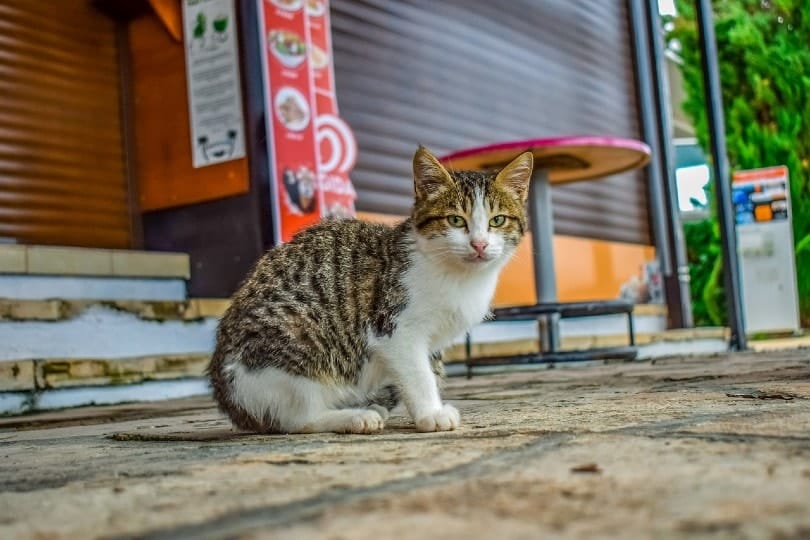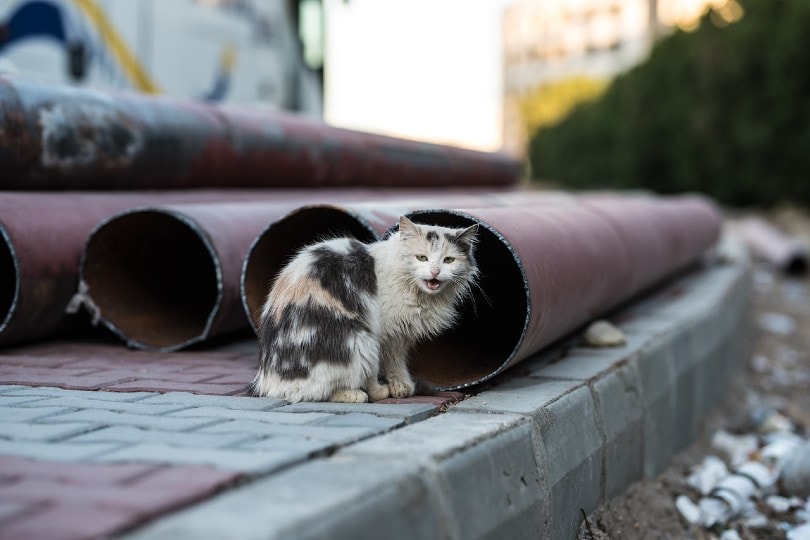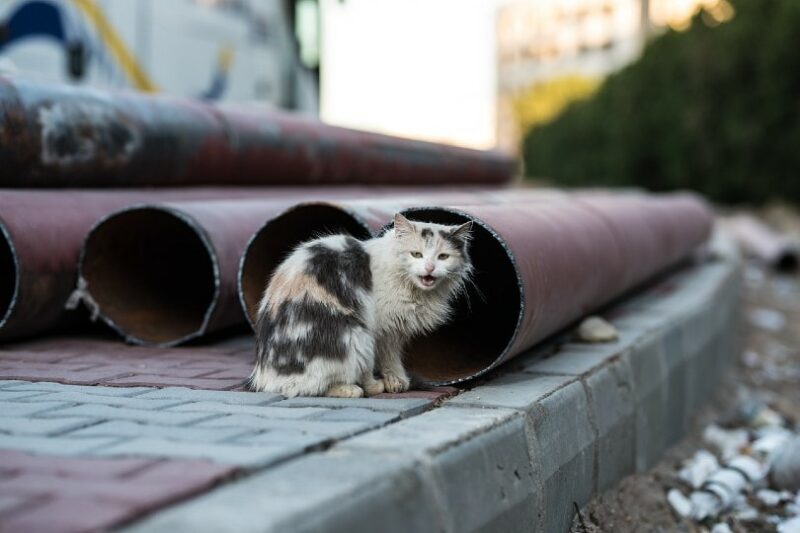Cats that have never been socialized with people or have reverted back to living as almost wild animals are referred to as feral cats. Feral cats can be difficult to approach and trust humans since they’ve never had any contact with them. But with the right techniques, you can help them lead a healthier and more comfortable life, although they are unlikely to ever make a true pet.
Here are five tips and tricks on how you can safely care for these cats, without necessarily changing the way they live or causing them any stress, as well as how you can attempt to socialize them as much as possible.
Please be mindful that approaching or catching feral cats for the purpose of neutering may be illegal in some countries or states. Check your local legislation. Feral cats are not used to human contact and may be aggressive. Catching them without the help of a professional is strongly discouraged, as it may lead to serious human injuries and will cause stress to the cat. There are ways you can help feral cats live better lives, but this is not by catching them or forcing them to become a pet. If you find a stray cat, get them to the local veterinarian so they can look for their previous owners if microchip details are available, or they can be put up for adoption.
Before We Begin: Why Is It Hard to Socialize Feral Cats?
Feral cats generally cannot be socialized with people or get used to a domestic environment, and even if you do manage to get one used to being around you, you are unlikely to ever bring one into your home. This would not be the right or moral decision for the cat anyway, as they are scared of people and used to a certain way of living, and anything besides that may cause them significant fear and distress.
Besides, it’s important to distinguish a feral cat, that has had very little or no positive experience with people, from a stray cat that has been socialized with people but may have gotten lost or abandoned. Stray cats can be rehomed unless there is an owner looking for them.
Kittens born to feral cats will often be easier to socialize than adult feral cats, but this also requires a great deal of time, knowledge, and patience and needs to be done at an early age, certainly younger than 8 weeks.
If you have found a cat that you believe may be stray or feral, please do not attempt to catch them yourself. The chances of getting injured are high and causes stress for the cat. It’s important to contact a local shelter or animal rescue organization, which can organize safe trapping of the cat within the local rules and legislation.
This way, the cat may be neutered or spayed, and if they are a stray and are familiar and friendly with people, they can be put up for adoption. If they are feral and terrified of people, the vet will do an ear tip by cutting off a very small part of the ear so the cat can be recognized as being neutered, making avoiding catching them twice unnecessary.
However, if you live in an area where there are feral or stray cats, there are ways you can care for them without causing them stress. Let’s look into five tips you can use to make their lives healthier and more comfortable.

1. Check Local Rules and Legislations
Before doing anything with the feral cat or cats in your neighborhood, it’s crucial to speak to a local animal warden and familiarize yourself with country and state legislation. It may be against the law to provide food for feral cats in certain areas, especially if there is an ongoing issue with their population or they are classed as vermin. Feeding feral cat colonies without performing a Trap-Neuter-Release (TNR) program may also prove counterproductive, as the cats will continue to reproduce, increasing their numbers and leaving an impact on the local wildlife, but also causing infectious disease spread between the cat.
After checking the legislation, speak to your neighbors, as they may have taken care of some of these cats, or some of the cats may frequent their yards. It’s good to get more people involved so you can share the care for these cats, as generally, colonies can consist of five or more cats, with new ones coming in every few months.
2. Speak to a Local Shelter or Vet Clinic
If TNR programs and feeding feral cats are legal in your country or state, contact a local animal shelter organization or a vet practice. They can direct you to the responsible organization, which can hopefully organize a neutering program for these cats.
Neutered and spayed feral cats are then returned to their original location, where they can continue to live a comfortable life without further reproducing and contributing to large numbers of feral cats. This will also minimize fighting during mating season and the transmission of infectious diseases, and it will improve the health of the colony and the individual cats as well.
Never attempt to catch or trap a feral cat yourself. This needs to be done by a professional. Leaving traps may not be allowed in some countries, as protected wildlife species may be caught by mistake.

3. Set Up a Safe Environment for the Cat
Although feral cats have learned to survive and fend for themselves out in the wild, they still appreciate shelter, food, and water. Setting up a safe environment for a feral cat to use can help the cat indirectly become familiar with at least the scent of a human so that the cat doesn’t feel as threatened.
If possible, provide an area for hiding and sleeping along with some soft bedding so that the cat has a place to stay warm. Place food and water bowls in the space to attract the cat. Doing this at the same time every day may help the cat to return to the spot if they know there will be food waiting.
4. Let the Cats Get Used to You
Once you have set up a safe environment for your feral cat, it’s time to let them get used to your presence, if that’s what you want and if the cat is not stressed, which may be the case in the majority of cases, particularly in the beginning. Don’t try to interact with the cat; instead, simply sit quietly near them for 15–20 minutes per day, while bringing them food and water. This will allow the cat to become accustomed to your presence without feeling threatened or overwhelmed.
As they become more comfortable, you can start talking softly and potentially offering treats depending on how close the cat will let you get. Some cats will never even come close when you’re there and will wait for you to leave so they can eat. And that’s fine, as they are not accustomed to people, and they may never lose that fear, so this should be respected. After all, you are there to provide them with the basic needs for life, and knowing you have improved their welfare and quality of living is a reward on its own.

5. Ensure Continuity of Care
Understand that even looking after feral cats is a responsibility that should not be taken lightly. If you are not able to make it a regular daily or every-other-day occurrence, it may be best not to commit. The issue is that these cats will become reliant on you for food and water (especially in the summer months), and if you go on holiday or fall ill, they will not understand what happened.
It would be good to set up a team in the neighborhood so you can dedicate days and weeks to individuals and cover each other if needed. It’s a big task and is not free, so working with a local charity may help to provide the food for the cats. If the cats are coming to your garden, they may as well move in, but do not expect them to come inside or become a pet cat.
Maintain a level of caution when it comes to physical contact, as some of the cats may be entirely feral and scared of people. Some of them may be more confident and get used to you, and they may even show an interest in becoming a house cat.
As the cats settle in their safe environment with a consistent food source, it’s likely that new cats will show up. Again, organizing a local shelter or vets to perform a TNR is crucial, so they can stop the group from becoming bigger and reduce disease transmission.
Other Tips & Tricks to Care for Feral Cats
The following tips offer specific approaches and solutions that can help you care for and attempt to socialize feral cats. While each situation is different, this best practice guide is ideal for helping you ensure minimal stress for these cats and the maximum available level of care while protecting yourself and your health.
- Start Off Slowly – Begin by offering food from a distance and then gradually move closer over time.
- Provide a Safe Space – Ensure there is appropriate shelter from the weather conditions and traffic, and allow the cats to choose if they wish to use it, with minimal disturbance and without feeling threatened.
- Provide Multiple Feeding Locations – Place food bowls in multiple locations around the area or the yard so the cats feel comfortable accessing them without feeling intimidated or crowded out by other animals in the space.
- Speak Softly & Move Slowly – Talk to the cat in a calm, quiet voice and keep your movements slow and gentle.
- Offer Rewards – Use treats or toys as rewards when particular cats display good behavior or actively seek your attention.
- Avoid Physical Contact – Be careful and refrain from touching the cats, as they are not used to it and may scratch or bite. This can be particularly dangerous in areas where rabies is prevalent. In case of any injuries, seek help from your doctor.
- Avoid Eye Contact – Staring directly into a feral cat’s eyes can be seen as confrontational and intimidating; try looking away instead.
- Don’t Crowd Them – Feral cats often feel boxed in and overwhelmed if approached too quickly or too closely; give them plenty of room to retreat if needed.
- Set Up Structured Interactions – Regular but gentle interactions can help build trust over time if done in small doses and at a safe distance.
- Give Them Time – Don’t expect the cats to fully trust you in one day. Give them time and patience to get used to new people.
- Seek Professional Advice – Speak to a local animal shelter or a veterinarian about TNR programs. Never try to trap feral cats yourself.
- Speak to a Veterinarian – Speak to the local vet about the TNR program and the best ways to care for these cats without causing them fear or distress.
What Else Do I Need to Know When Caring for Feral Cats
Feral cats are resilient and resourceful animals that can find a way to survive in almost any environment. However, it is important to remember that these cats have likely been living on their own for some time and are generally accustomed to taking care of themselves.
There may be aspects where you can help, but unfortunately, in many ways, they are left to fend for themselves. In some cases, if they are ill or in need of veterinary treatment, they may get used to you enough to be able to trap them more easily. However, some cats will still never be comfortable around people, and they will not allow being caught.
Be mindful of your own health, as you may pick up fleas and ticks from the cats or take it home to your own kitty, and scratches and bites may lead to skin infections or worse.

- Flea infestations – Feral cats often carry fleas or ticks.
- Infectious diseases – Feral cats may be infected with feline leukemia virus, feline immunodeficiency virus, or something else. Vaccinating them is not possible, although in some TNR programs they may get a single dose.
- Neutering/spaying – This will prevent the spread of unwanted kittens in your area.
- Feeding schedule – Feed the cats at regular intervals so they learn when to expect their next meal.
- Appropriate shelter – Feral cats may benefit from access to an appropriate shelter, such as a bed, covered house, or even a large cardboard box that is well insulated, waterproofed if needed, and somewhere away from traffic.
- Observe their health – Pay attention to their behavior and any changes that may arise as you get to know them better over time. However, it does not mean they will get veterinary care, as this will mainly depend on their personality, the ease of catching them, and financial support from donations to cover vet bills.
By taking the necessary steps outlined above, you can help ensure the feral cat in your care transitions into their new home comfortably and safely.
Common Medical Problems in Feral Cats
Feral cats can sometimes have underlying medical issues that may not be immediately visible or known. As discussed above, you may not be able to take some of them to a vet, but others may allow being trapped and having veterinary treatment, particularly for acute problems. Common health problems in feral cats include:

- Parasites: Fleas, ticks, mites, and worms may all be present in feral cats.
- Upper Respiratory Infection: This is caused by viruses such as the feline herpes virus (FHV) and may sometimes cause serious illness.
- FIV/FeLV: These two retroviruses are common among feral cats and can cause various signs, such as weight loss, frequent infections, slow wound healing, predisposition for cancer, anemia, and loss of appetite.
- Injuries & Trauma: Feral cats are often exposed to injury or trauma due to their outdoor environment.
- Dental Disease: Poor dental health can lead to chronic pain and tooth root infection in feral cats.
- Fight Wounds: Feral cats are often involved in fights with other animals and may have wounds or scars as a result.
- Pregnancy: Cats reproduce quickly. Cat gestation is about 63 to 65 days, which is why TNR programs are so valuable.
 Socializing and Caring for Feral Cats: Final Thoughts
Socializing and Caring for Feral Cats: Final Thoughts
Looking after a feral cat colony or even just a few feral cats comes with many responsibilities and challenges, but it’s also incredibly rewarding. With patience and consistency, feral cats can learn to trust people, but more importantly, you will provide them with the basic requirements for a healthy and happy life. Remember that good communication with your local vet and animal shelter is essential in order to ensure you are doing everything according to legislation and in the cats’ best interests. By taking the necessary steps to ensure their health, safety, and comfort, you are making a big difference in these cats’ lives!
Featured Image Credit: museumsmaus, Pixabay
Contents
- Before We Begin: Why Is It Hard to Socialize Feral Cats?
- 1. Check Local Rules and Legislations
- 2. Speak to a Local Shelter or Vet Clinic
- 3. Set Up a Safe Environment for the Cat
- 4. Let the Cats Get Used to You
- 5. Ensure Continuity of Care
- Other Tips & Tricks to Care for Feral Cats
- What Else Do I Need to Know When Caring for Feral Cats
- Common Medical Problems in Feral Cats
- Socializing and Caring for Feral Cats: Final Thoughts





 Socializing and Caring for Feral Cats: Final Thoughts
Socializing and Caring for Feral Cats: Final Thoughts






